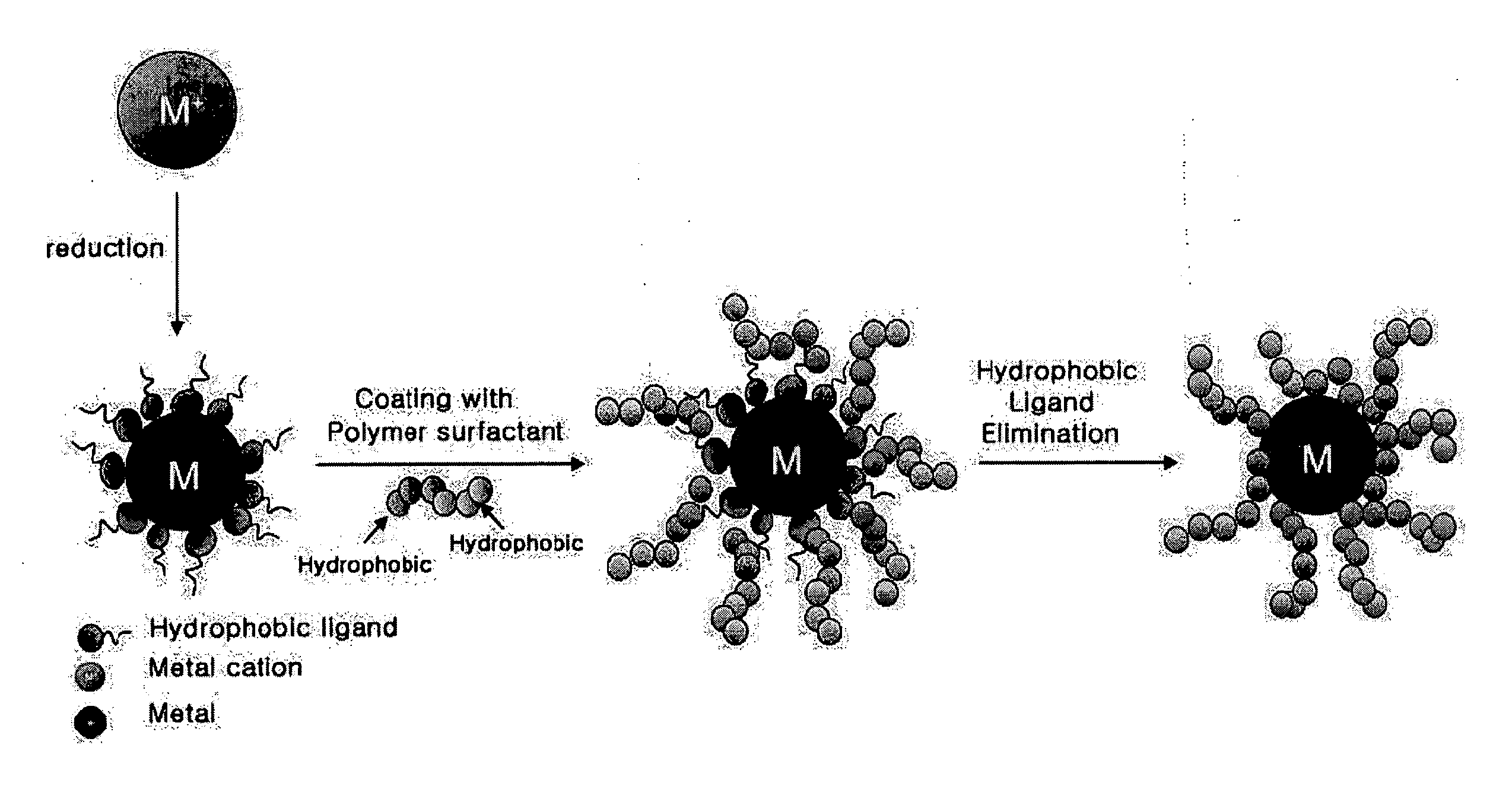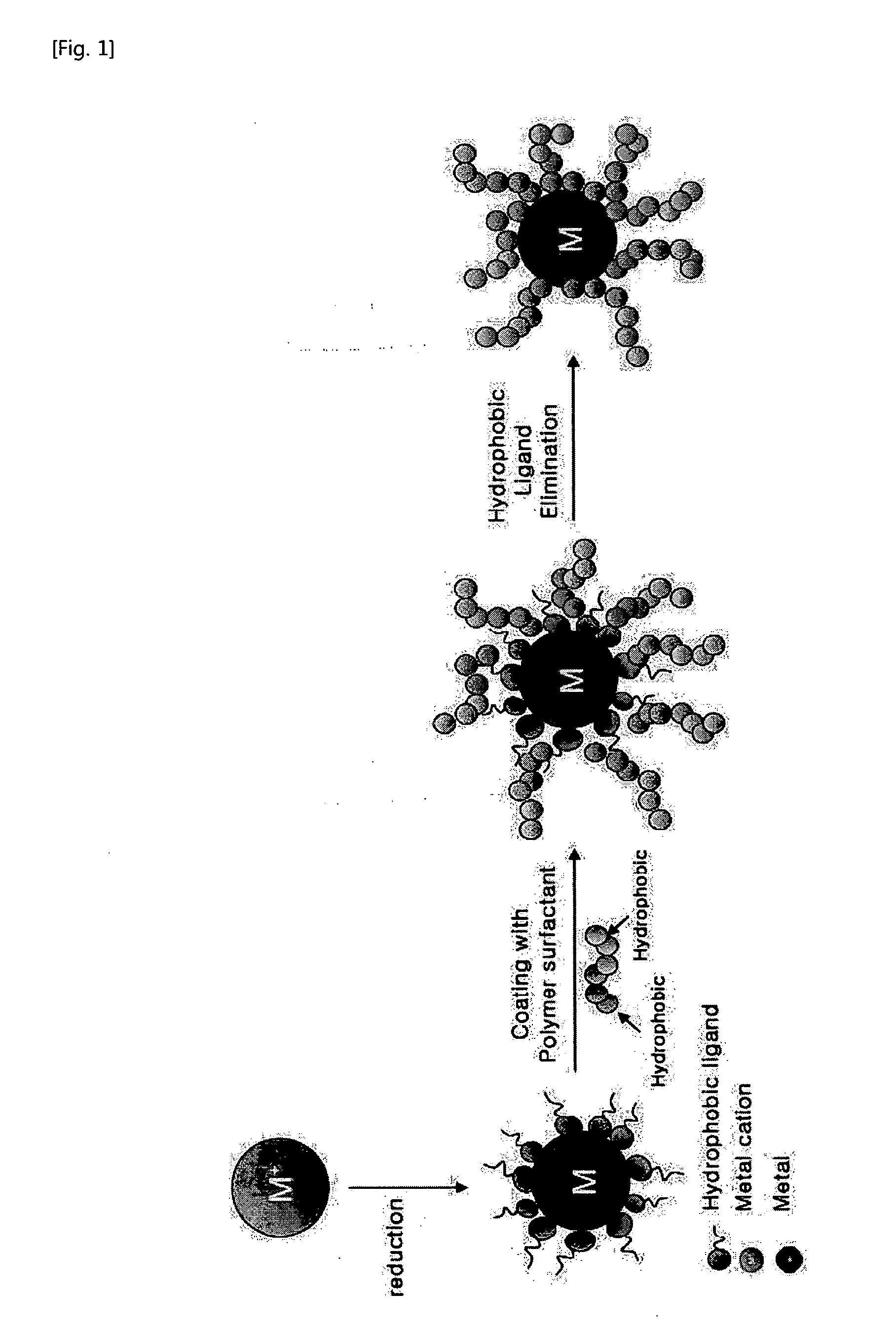Method for Preparing Water-Soluble Nanoparticles and Their Dispersions
- Summary
- Abstract
- Description
- Claims
- Application Information
AI Technical Summary
Benefits of technology
Problems solved by technology
Method used
Image
Examples
preparation example 1
Preparation of 6 nm Hydrophobic Silver (Ag) Nanoparticles
[0053]Silver acetate (50 g), as a metal precursor, and oleic acid (30 g) were dissolved in toluene (300 mL) at 70 C. Then, reaction was carried out by adding hydrazine (50 g) as a reducing agent. Reaction temperature was increased at a rate of 10 C. / min. The reaction was performed at 100 C. for 2 hours. After the reaction was completed, the reaction mixture was cooled to room temperature, washed by adding ethanol, and then separated by centrifugation. FIG. 2 shows a transmission electron microscopy (TEM) image of thus prepared nanoparticles.
example 1
Hydrophilic Treatment of 6 nm Ag Nanoparticles Using Alkali-Soluble Resin
[0056]The hydrophobic Ag nanoparticles (2 g) prepared in Preparation Example 1 were dissolved in toluene (50 g) and uniformly dispersed for 30 minutes using a homogenizer. A surface modification solution was prepared by dissolving an alkali-soluble resin (Soluryl 70, weight average molecular weight=7000, Hanwha Chemical, 5 g) and BYK192 (BYK Chemie, 3 g) in methanol (100 g). The dispersion of nanoparticles was added thereto dropwise at a rate of 10 mL / min. After allowing to react for 15 minutes and then adding tetramethylammonium hydroxide (TMAOH) / methanol 15 wt % solution (5 mL), the resulting mixture was allowed to react again for 15 minutes. Then, the nanoparticles were recovered by centrifugation after rinsing twice with ethanol (100 g). FIG. 4 shows a TEM image of thus prepared particles. It was observed that the hydrophilically treated nanoparticles retained their particle size of 6 nm or smaller. When th...
example 2
Hydrophilic Treatment of 6 nm Ag Nanoparticles Using Pluronic Polymer
[0057]Hydrophilic treatment was performed in the same manner as Example 1, except for using Pluronic F127 (weight average molecular weight=12,700, BASF, 3 g) instead of the alkali-soluble resin. TEM analysis revealed that the particle size was retained after the hydrophilic treatment. When the particles were dispersed in an aqueous medium, the dispersion remained stable for over 3 months.
PUM
| Property | Measurement | Unit |
|---|---|---|
| Percent by mass | aaaaa | aaaaa |
| Percent by mass | aaaaa | aaaaa |
| Percent by mass | aaaaa | aaaaa |
Abstract
Description
Claims
Application Information
 Login to View More
Login to View More - R&D
- Intellectual Property
- Life Sciences
- Materials
- Tech Scout
- Unparalleled Data Quality
- Higher Quality Content
- 60% Fewer Hallucinations
Browse by: Latest US Patents, China's latest patents, Technical Efficacy Thesaurus, Application Domain, Technology Topic, Popular Technical Reports.
© 2025 PatSnap. All rights reserved.Legal|Privacy policy|Modern Slavery Act Transparency Statement|Sitemap|About US| Contact US: help@patsnap.com



